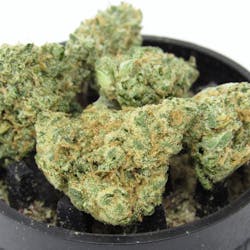Full-spectrum extracts, often called whole plant extracts, maintain the full profile of the cannabis plant. They contain a variety of cannabinoids, including THC, THCa, CBD, CBDa, CBG, and CBN, as well as terpenes and other compounds such as flavonoids, proteins, phenols, sterols, and esters.
These extracts are desirable for several reasons. From an experiential standpoint, they replicate the flavor and aroma profile of the plant. From a therapeutic or medicinal standpoint, you get the full benefits of the entourage effect—the theory that the various components of the plant work synergistically to enhance the action of the active substances, such as THC and CBD.
Full-spectrum extracts are notoriously difficult to produce. While you need to keep as many of the desirable compounds as possible, you also want to rid the extract of unnecessary components. Some extraction methods filter the latter out using a variety of refinement techniques.
However, those very techniques often strip extracts of some of the more delicate compounds such as terpenes and flavonoids.
Methods used to produce full-spectrum extracts
The processes used to create full-spectrum extracts must dance a fine line to keep the wanted compounds in and the unwanted out.
Note that the full spectrum of compounds of a given strain is relative to the point at which the extraction is performed. For example, a live resin extract taken from a fresh plant will have a different profile than an extract of dried plant material. This is because some compounds change during the drying process.
What’s more, the profile of a plant can depend on various other factors, including the part of the plant, its age, and environmental factors. As such, you could have multiple full-spectrum extracts of the same strain that all have different profiles.
Hydrocarbon extraction
Hydrocarbon extraction uses butane or a butane-propane blend to create full-spectrum extracts. This method allows for the profile of an extract to be tweaked.
In this type of extraction, hydrocarbon gas is cooled and liquefied before being passed over raw plant matter. The desirable compounds from the plant are dissolved and the resulting solution is refined using various techniques, such as winterization and dewaxing. Both of these processes use additional solvents and low temperatures to remove wax and lipids from the final product.
Full-spectrum extracts can be finicky, so the process parameters must be exact. Small changes in solvent composition and temperature can result in a different product. For example, a small increase in temperature might volatilize certain terpenes, changing the flavor profile of the extract.
Supercritical CO2 extraction
In supercritical CO2 extraction, temperature and pressure are used to create phase changes in CO2. It goes from being a gas to displaying properties of both a gas and a liquid. It has a gas-like viscosity and low surface tension, so it more easily penetrates porous solids than a liquid does. This results in a substance that forces out compounds of plant matter based on their weights.
By adjusting the temperature and pressure, you can “tune” the CO2 to create a very precise environment whereby the supercritical fluid will only extract the most desirable components. While CO2 extraction involves complex pieces of equipment, it requires little or no post-processing, unlike other extraction methods.
Pressure
The idea behind full-spectrum extracts is that unwanted components are removed. For example, some plant lipids can lead to poor flavor or a harsh vapor. That said, certain concentrates containing these lipids, such as rosin, are sometimes considered full-spectrum. Rosin is made by squeezing resin from the starting material (such as dry sift) using heat and pressure, often with a special rosin press.
The main benefit here is that processing doesn’t require the use of a solvent and it is relatively safe. However, because heat is involved, there is a concern that some of the desirable components of the plant, such as terpenes, are lost in the process.
Finding full-spectrum cannabis products
There is little regulation to determine what constitutes a full-spectrum extract, and some products are labeled as such even when they don’t meet the general definition. The only real way to tell is to examine the lab test results for the extract.
Here are some product names to look out for when selecting a full-spectrum extract.
Live resin
Live resin is produced using fresh (sometimes frozen) cannabis plants instead of dried plant material. Not all live resins are full-spectrum extracts, and their composition will depend on how they are processed.
If it’s extracted using one of the above methods, then you could obtain a full-spectrum extract. But, for example, if you use a process that involves heat, you’ll lose certain compounds from the plant profile, such as terpenes.
High terpene full-spectrum extract (HTFSE)
The extraction process for this product is designed to yield a high level of terpenes, sometimes up to 40%. It is viscous and clear with a consistency similar to honey. Some HTFSEs are labeled as “sauce” or “terp sauce,” names that indicate the high terpene content. However, not all sauce is full-spectrum.
High cannabinoid full-spectrum extract (HCFSE)
For HCFSE, processes are tweaked so that the final product has a high cannabinoid concentration. The result is a crystalline structure, similar to sugar or diamonds. Although HTFSE and HCFSE can be produced from the same plant, they are both considered full-spectrum extracts since they still contain the full roster of desirable compounds present in the raw material, albeit at different levels.




